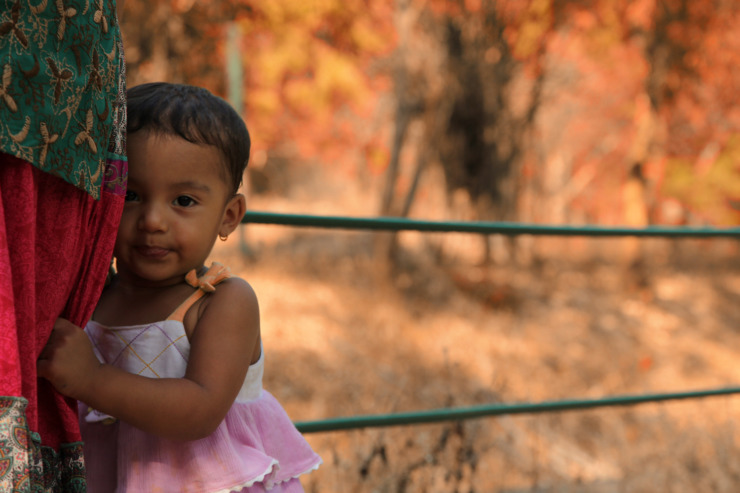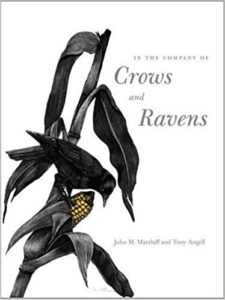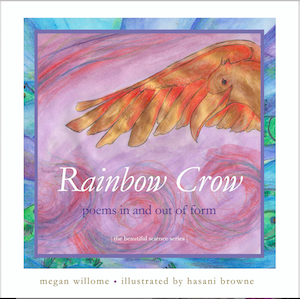Beautiful Science + Crows
The pursuit of truth and beauty is a sphere of activity in which we are permitted to remain children all our lives.”
– Albert Einstein, Nobel prize-winner in physics, 1921
Truth and Beauty: the sphere of poets
Science: the sphere of scientists
Magic: when the three become one
I consider John M. Marzluff’s In The Company of Crows and Ravens magical, and not just because I like crows. The book does for me what Einstein describes, allowing me to remain childlike. It unites the heavens and the earth on the wings of some very bad birds. Believe me, I know them.
One April day I saw a crow steal my son’s glasses, child’s glasses with light metal frames. I knew crows liked to steal shiny things, but these were gray. When I couldn’t find the glasses, I went looking for answers and the library gifted me with Marzluff’s book, which I later purchased and keep handy, for easy reference.
Most of the books that I dogear and highlight and make notes in are fiction because story steers my soul. This book is an exception. It’s not even memoir — it’s a scientific examination of corvids and their interactions with humans, including how they have influenced our myths, legends, poetry, and even our words. I still have the original pages of notes I took the first time I read the book, seventeen years ago.
The very first sentence proclaims, “Crows demand our attention.” That April day, when the glasses were swiped, crows got my attention. They’ve never un-gotten it.
Science doesn’t have to mean boring. This book filled with unforgettable anecdotes from Professor Marzluff’s environmental research at the University of Washington. Science doesn’t have to mean just the facts, ma’am. The book examines a theory: that our lives are intertwined with the lives of these birds, and that we need each other to thrive. Science doesn’t have to mean numbers only. It also means beauty, and Tony Angell’s pen-and-ink drawings are frame-worthy.
Marzluff’s perspective is that crows and ravens reveal our connection to the Earth. Are we working with nature or against it? Our corvid friends have perspective specific to our localities. The book continues to make me consider my home — with its grasses, trees, plants, bushes, flowers, and critters seen and unseen — as a habitat. Who lives with me? How can we help each other?
And do I really want to help Crow, that loud-mouthed, thieving trickster?
The crow’s use of rudimentary language raises another possibility: good talkers make good liars. The fact that crows and ravens are so often seen as tricksters and outright prevaricators in our legends and stories suggests that early people were often deceived by cunning corvids.”
Deceived or not, we writers keep writing about crows. The book has a list of fifty-seven children’s books that feature crows and ravens, and that was back in 2005. There are scads of poems about these birds. Whether they are exchanging gifts with a child or stealing from one, they caw to the child within us all.
What does it mean — as Einstein advocates — to remain children all our lives? It means to be curious. It means to never accept ugly truth or false beauty. It means to look up. And if crows are around, look out!
Your turn
1. What is a book outside your preferred genre or format that you enjoyed?
2. Do you have a favorite book or poem about ravens and/or crows?
3. Share your March pages. Sliced, started, and abandoned are all fair game.
March’s Pages
Poetry
The Essential Neruda: Selected Poems, by Pablo Neruda, edited by Mark Eisner with a team of translators
What the Heart Knows: Chants, Charms & Blessings, by Joyce Sidman, illus. Pamela Zagarenski (Join us for Children’s Book Club next Friday, April 15!)
Picture Books and Early Readers
The Snowy Nap, by Jan Brett
Click, Clack, Moo: Cows That Type, by Doreen Cronin, illus. Betsy Lewin
Line and Scribble, by Debora Vogrig, illus. Pia Valentinis
Middle Grade and YA
Speak, by Lauren Halse Anderson
The Wind in the Willows, by Kenneth Grahame (reread)
The Outsiders, by S.E. Hinton (credited with inventing YA in 1967)
Grownups
In the Company of Crows and Ravens, John M. Marzluff
Henry IV, part 1, by William Shakespeare (abridged)
The Hobbit, by J.R.R. Tolkien (reread)
Made Progress
Boomtown, by Sam Anderson (the book I really needed to read before writing about the generosities of Oklahoma)
Photo by Vinoth Chandar, Creative Commons, via Flickr. Post by Megan Willome.
Browse more book reviews with Perspective
- Perspective: The Two, The Only: Calvin and Hobbes - December 16, 2022
- Children’s Book Club: A Very Haunted Christmas - December 9, 2022
- By Heart: ‘The night is darkening round me’ by Emily Brontë - December 2, 2022



Glynn says
A favorite book about crows – Max Porter’s poetic novel (or novelistic poetry) “Grief is a Thing with Feathers.” And it was his debut work!
March reading:
Fiction
Like No Other Boy by Larry Center
Alexandria by Paul Kingsnorth
Dancing Prophet by myself
Non-fiction
Diary of a Confederate Tarheel by Louis Leon
Only When I Step on It by Peter Conti
Redemption: The church in Ancient Times by Luke Davis
Reign: The Church in the Middle Ages by Luke Davis
Grierson’s Raid by Dee Brown
Mystery
The Fox Hunting Murder by Roy Lewis
The Other Victim by Helen Durrant
A Death in Jerusalem by Jonathan Dunsky
A Dartmoor Murder by Roy Lewis
The Moor Road by Glenn McGoldrick
An Unfortunate End by Lisa Zumpano
Broken Glass by Alexander Hatung
Poetry
Transit by Kelly Belmonte (photos by Tom Darin Liskey)
Heart Speaks, Is Spoken For by Marjorie Maddox Hafer
Begin with a Question by Marjorie Maddox Hafer
Drinking Guinness with the Dead by Justin Hamm
Wading through Lethe by Paulette Guerin
Megan Willome says
I am forever grateful for you to introducing me to Max Porter’s debut novel. It sits on a special shelf in my desk, right on top of “In the Company of Crows and Ravens.”